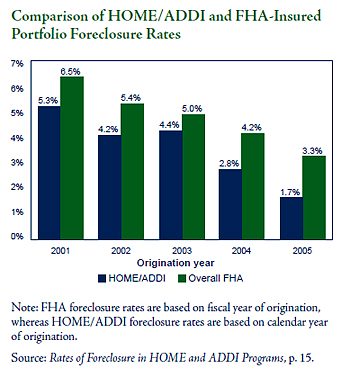December/January 2010
In this Issue
New Approach To Serving Vulnerable Families
Foreclosure Risk Lowered With Downpayment Assistance
Stabilizing Communities With NSP Dollars
Models of Sustainable Affordable Housing
In the next issue of ResearchWorks
Foreclosure Risk Lowered With Downpayment Assistance
 The recent housing crisis has made clear the
importance of ensuring that when a family
achieves homeownership, it is a sustainable
homeownership. There is always a tension when
attempting to expand homeownership, with the risk
that households will be unable to meet mortgage
obligations and remain in the homes they purchased.
This was the concern Congress had in 2006 when
it directed HUD to determine foreclosure and
delinquency rates for those who received assistance
through the American Dream Downpayment
Initiative (ADDI), a program designed to help expand
homeownership among lower-income households.
The recent housing crisis has made clear the
importance of ensuring that when a family
achieves homeownership, it is a sustainable
homeownership. There is always a tension when
attempting to expand homeownership, with the risk
that households will be unable to meet mortgage
obligations and remain in the homes they purchased.
This was the concern Congress had in 2006 when
it directed HUD to determine foreclosure and
delinquency rates for those who received assistance
through the American Dream Downpayment
Initiative (ADDI), a program designed to help expand
homeownership among lower-income households.
According to the resulting study, Rates of Foreclosure in HOME and ADDI Programs, such difficulties seem to be the exception, not the rule.1 This study finds that foreclosure rates among homebuyers assisted through the HOME and ADDI programs were lower when compared with the subprime market and with overall foreclosure rates for buyers with loans insured by the Federal Housing Administration (FHA). Established by the American Dream Downpayment Act of 2003, the ADDI program was funded in fiscal years 2004–2007. ADDI provided assistance with downpayments, closing costs, and rehabilitation associated with a home purchase. ADDI was not subsequently funded because HOME programs also offered the kind of assistance that made homeownership affordable and sustainable for low-income families. The funding was allocated to existing HOME programs created under Title II of the National Affordable Housing Act of 1990.2
 Because both programs served lower-income
homebuyers, researchers combined data from the two
programs to obtain a larger study group. Researchers
gathered information from a representative sample of
more than 4,000 homebuyers identified by state and
local governments that administered the program.
The estimated annual foreclosure rates of HOME
and ADDI participants from 2001 through 2005
were then compared with those of the FHA-insured
mortgage portfolio as of early 2008 — a similar
population of homeowners, many of whom have
low incomes and are first-time homebuyers. The
differences were statistically significant. Between
2001 and 2005, foreclosure rates among HOME
and ADDI participants were 25 percent lower than
the rates found among all FHA-insured borrowers.
Loans originating in earlier years (2000–2002)
had higher rates of foreclosure than those in more
recent originations (2003–2005), in part because the
longer a loan is in existence, the more time it has to
experience a foreclosure.
Because both programs served lower-income
homebuyers, researchers combined data from the two
programs to obtain a larger study group. Researchers
gathered information from a representative sample of
more than 4,000 homebuyers identified by state and
local governments that administered the program.
The estimated annual foreclosure rates of HOME
and ADDI participants from 2001 through 2005
were then compared with those of the FHA-insured
mortgage portfolio as of early 2008 — a similar
population of homeowners, many of whom have
low incomes and are first-time homebuyers. The
differences were statistically significant. Between
2001 and 2005, foreclosure rates among HOME
and ADDI participants were 25 percent lower than
the rates found among all FHA-insured borrowers.
Loans originating in earlier years (2000–2002)
had higher rates of foreclosure than those in more
recent originations (2003–2005), in part because the
longer a loan is in existence, the more time it has to
experience a foreclosure.
The study explored the effects of a number of other variables on delinquency, default, and foreclosure rates. Stricter credit eligibility requirements and greater equity through homebuyer assistance and borrower cash were related to lower foreclosure rates. Adjustable-rate mortgages, high-cost loans, reliance on lenders to keep interest rates down, nonprofit seller-funded downpayment programs, and declining prices of surrounding homes, on the other hand, were all associated with higher foreclosure rates.
A factor that is strongly linked with higher foreclosure rates among HOME- and ADDI-assisted homebuyers was the use of FHA-insured mortgages. The researchers hypothesize that HOME- and ADDI-assisted homebuyers who had "poorer credit histories were more likely to rely on FHA-insured mortgages" and less likely to obtain prime mortgages. The prevalence of these riskier homeowners in the FHA portfolio resulted in these homebuyers having higher rates of foreclosure in comparison to HOME- and ADDI-assisted buyers. Nevertheless, "their foreclosure rate was still much lower than the rates experienced by buyers using seller-provided downpayment assistance and only slightly higher than the foreclosure rates of the overall FHA-insured portfolio."3
Overall, the study concludes that the HOME and ADDI programs succeeded in making sustainable homeownership possible among low-income households. However, because the study period ended before the mortgage crisis began in earnest, and because these mortgages were not significantly involved in the subprime market, an analysis of their subsequent performance is not yet available.
1 Karmen Carr, Christopher Herbert, Ken Lam, and Yusuf Makhkamov, Rates of Foreclosure in HOME and ADDI Programs, U.S. Department of Housing and Urban Development, Office of Policy Development and Research, 2008. The report can be downloaded at www.huduser.gov/publications/hsgfin/addi. html. Print copies can be ordered by calling HUD USER at 800.245.2691, option 1.
2 For information on the HOME Investment Partnerships Program, click on www.fhasecure.gov/offices/cpd/affordablehousing/ programs/home.
3 Carr, et al., p. 41.

